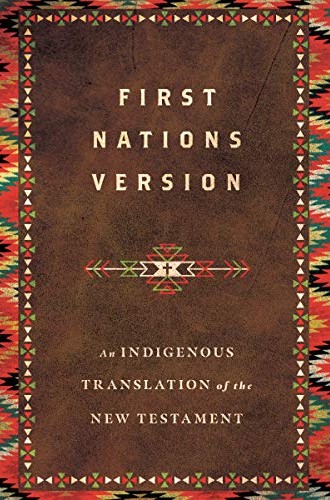A New Testament that connects the heart languages of First Nations people
The translators hope that “the colonial language that was forced upon us can now serve our people in a good way.”
The First Nations Version of the New Testament is the brainchild of Terry M. Wildman (Ojibwe and Yaqui), who served as the lead translator and collaborated with members of over 25 tribes across North America to make it a reality. This English language contextualization of the New Testament is the first of its kind, and it is meant for “English-speaking First Nations People,” “the entire sacred family,” and “all the churches . . . and especially [those] involved in contextual ministry with Native North Americans.” According to the introduction, it was produced out of a desire to connect in a culturally relevant way to the traditional heart languages of the First Nations people of Turtle Island (North America).
I’m an adult learner of Cree—the language my ancestors spoke—and an advocate for minority-language translation projects, as a road to both language preservation and surplus of meaning. So I couldn’t help but be intrigued by the ambitious task Wildman and his associates undertook—and also somewhat skeptical. I read the FNV with an eye toward its ability to navigate the contentious waters of what constitutes First Nations rhetoric and terminology without indulging in what might be seen as stereotypical or what the translators refer to as “culturally degrading simplicity.” Based on my own research into orality and literacy, I believe the translation team largely succeeded in this endeavor.
My work is set on calling Bible translators to be aware of and honest about the rhetorical aims of their translations, and I appreciate the FNV’s introduction for laying this out quite humbly and clearly. The translators also show an awareness of the complicated relationship between First Nations people and the Christian church.
They acknowledge the adoption of dynamic equivalence as their methodology, with its focus on translating thought-for-thought rather than word-for-word. The choice of this translation method and theory lines up with oral storytelling conventions, which allow for a surplus of meaning not necessarily applicable at the word level. As French philosopher Paul Ricoeur explains in Interpretation Theory (1976), translation is a dialogue between translator and text that begins with the text as a whole (rather than merely as words or sentences) and emerges from the translator’s sense of the spirit of the culture that produced it. In this dialogue, the text is both suppressed and surpassed as a surplus of meaning emerges and comes down to the level of sentence and word.
Perhaps the most encouraging and elucidating element of the FNV is how it uses the meaning of names for both people and places. For example, the name “Jesus” is rendered “Creator sets Free.” A benefit of this translation approach can be seen in Matthew 16:18:
For this reason, I have given you the name Stands on the Rock (Peter), and upon this great rock I will make my sacred family stand strong. And the powers of the Dark Underworld of Death (Hades) will not stand against them.
The Greek names πέτρᾳ (petra) and ᾅδου (hadou) give depth to the passage for both Native and non-Native readers. These types of intricacies are not immediately available to readers without knowledge of the original Greek or Hebrew names.
I also support the FNV’s inclusion of a prologue that outlines the events of the Old Testament. This section of the prologue in particular resonated with me and with other First Nations people I read it to:
The Great Spirit made a peace treaty with the tribes and gave them their own Land of Promise, ceremonies to purify them, and feasts to teach them to celebrate his goodness. He also gave them their tribal law, which was carved into tablets of stone, and a sacred tent lodge, where they would perform their ceremonies.
Never before have I encountered a translation which points so directly to the connection between First Nations traditional beliefs and the gospel story.
Mark 1:6 also exemplifies this connection: “Gift of Goodwill (John) came wearing buffalo-skin garments, with a cowhide sash around his waist.” While some may take issue with the choice to use “buffalo-skin” instead of “camel-skin,” the translation brings to mind a visual that would be otherwise unavailable to someone who has never seen a camel or had a word to describe one.
My critiques of this translation, on first reading, are mainly aesthetic. Some of the people I talked to found it difficult to navigate its way of expressing names and suggested that it would be easier if the names were set apart typographically in some way. Others wished that the volume included maps or Indigenous arts representations of key elements of the story. Furthermore, given that this translation was produced with orality in mind, including an audio version of the translation with the book would encourage readers to engage with the text on this level. The cadence and style of the translation might be better appreciated if this were included.
While I continue to advocate for the ongoing work of First Nations language revitalization through Bible translation, I was surprised and pleased at this translation’s ability to open the door to decolonizing the gospel while still operating in the sphere of English, a language centered around literacy. On the dedication page, the translators lay out their hope that their translation “will bring healing to those who have suffered under the dominance of colonial governments” and that “the colonial language that was forced upon us can now serve our people in a good way.”
Time will tell whether the First Nations Version is accepted by its target audience and the wider Christian community. In the meantime, it stands as a refreshing and engaging take on the greatest story ever told. A tangible reflection of our times, it shows how far we’ve come and displays the richness that Indigenous perspectives bring to the gospel story.






